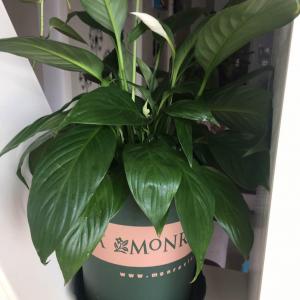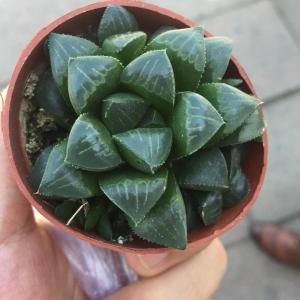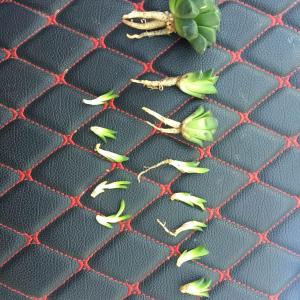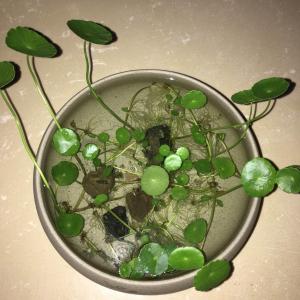文章
Colour_
2017年08月08日

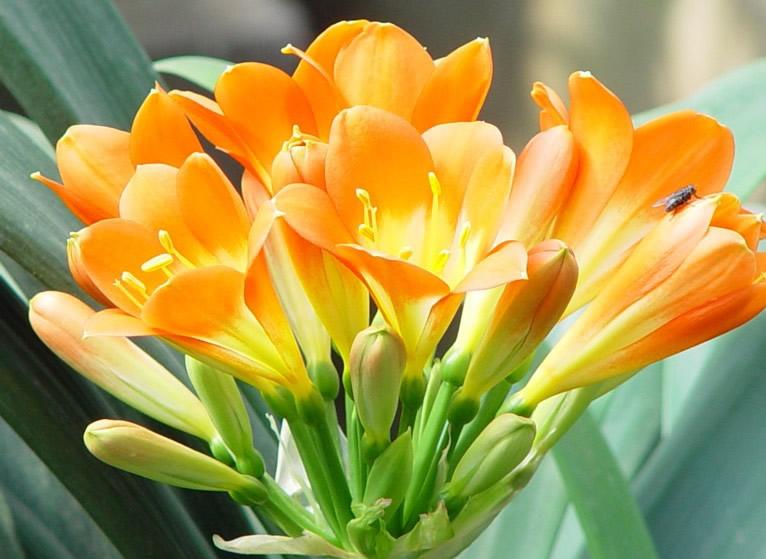
君子兰主要通过种子播种进行繁殖。
#君子兰 的花期是入冬后至次年3-4月份,花后种子成熟也需9-10个月,故君子兰的播种宜在11-12月份。播种前要进行选种,将空瘪发育不良的种子剔除。可用一般花盆播种,下面用粗沙砾或碎石砾铺成2厘米厚的排水层,然后铺一层腐叶土和河沙混合的培养土,厚约4-5厘米,在铺上0.5-1厘米的河沙作播种层。点播时,株距2厘米,然后用沙覆盖。覆土后浸1次水,盖上玻璃盖。播后保持20℃-25℃的气温有利发芽。
从发芽到长出第一片叶需2个月,以后要揭开玻璃盖通风,并逐渐去掉玻璃盖。播后90天便可移栽。移植时,先用竹签或竹筷扎孔,将肉质根插入土中,深度以埋住根茎露出种子为宜,同时注意叶片朝向一致。移后浇1次透水,过数日缓苗后再接受光照。苗期温度控制在15℃-20℃,冬春可见阳光,春、夏季应在散射光下生长,入秋后即可定植栽培。

君子兰分株繁殖,需做好以下工作:
①家庭盆栽宜用泥瓦盆,这种盆透气性好,有利于植株生长。
②准备好已消毒过的介质土。如用腐殖土混合细沙的,腐殖土要用高锰酸钾1000-2000倍水溶液喷洒消毒;细河沙也要用开水烫洗消毒,避免幼苗受病菌感染腐烂。
③准备少量木炭粉涂抹伤口,供吸潮防腐之用。
④分株时,将君子兰从盆中磕出来,拍松盆土,理顺根系,找出可以分株的腋芽:如果子株长在母株的外沿,株体较小,可以一手握住鳞茎部分,另一手捏住子株基部,轻轻一掰,就能将子株掰离母株;如果子株粗壮,则用锋利的刀将其切下。然后用于木炭粉涂抹伤口,以吸干流液,防止腐烂。让子株、母株在室内晾干后再种植,种植深度以埋住子株的基部假鳞茎为度,靠植株的部位要使其略高些,并盖上已消毒的沙土。种好后过2天再浇1次透水,2周后待伤口愈合时,再加盖一层培养土。一般需1-2个月才能生出新根,1-2年后便可开花。
0
0
文章
Dummer. ゛☀
2017年08月07日

The genus Gladiolus comprises 260 species, 250 of which are native to sub-Saharan Africa, mostly South Africa. About 10 species are native to Eurasia. The impressive flower spikes of Gladioli come in a wide array of beautiful colors.
Some Interesting Facts About Gladiolus Flowers
An ancient name for the gladiolus was xiphium, from the Greek word xiphos, also meaning sword.
The Gladiolus flower is the birth flower for August.
Gladiolus represented the Roman Gladiators, before the African Gladioli became popular in the West.
African Gladioli were imported in large quantities to Europe from South Africa during the 18th century.
Most of the more than 10,000 named Gladioli cultivars probably were derived from just seven species native to South Africa and first brought to European gardens in the late 17th century.
The Mediterranean and British Gladiolus flowers were used to treat physical ailments.
Some parts of the Gladiolus plant are poisonous if ingested and handling some species may cause skin irritation or allergic reactions.
The English used the gladiolus flower's stem base (corms) as a poultice and for drawing out thorns and splinters; powdered corms mixed with goat's milk were commonly used to soothe the symptoms of colic.
Scab, Fusarium Rot and Yellows, Penicillium Storage Rot, Leaf Spots and Blights, Stromatinia Corm Dry Rot, Virus and Phytoplasma Disease are the Common Gladioli diseases.
About Gladiolus Flowers and Plants
Gladiolus bulbs are not true bulbs. Gladiolus bulbs, in botanical terminology, are referred to as corms. A corm is a shortened and thickened section of the stem that appears at the base of the plant. On the corm are buds for each layer of leaves. Except for production of new varieties, Gladioli are not cultivated from seed.
Gladiolus plants are attractive, perennial herbs and semi hardy in temperate climates. They grow from rounded, symmetrical corms that are enveloped in several layers of brownish, fibrous tunics.
The fragrant Gladiolus flower spikes are large and one-sided, with secund, bisexual flowers.
Each Gladiolus flower is subtended by 2 leathery, green bracts. The sepals and the petals are almost identical in appearance, and are termed tepals. They are united at their base into a tube-shaped structure. The dorsal tepal is the largest, arching over the three stamens.
The outer three tepals of the Gladiolus are narrower. The Gladiolus perianth is funnel-shaped, with the stamens attached to its base. The Gladiolus style has three filiform, spoon-shaped branches, each expanding towards the apex.
The gladioli thrip, a very tiny, black, winged insect, is a real threat to Gladioli flowers and plants. It sucks the juice from the plant, leaving a silvery appearance, eventually causing the plant to turn brown. Gladioli thrips also cause deformed flowers and prevent flower spikes from opening.
Growing/Planting Gladiolus
Gladiolus can be propagated by dividing rhizomes, tubers, corms or bulbs (including offsets).
Plant Gladiolus as early in the spring as the soil is fit to work.
Gladiolus corms can readily be purchased at your local garden center or nursery, though they can easily be grown from seeds.
Sow the seeds in early spring, in a well-drained flat 8 to 10 inches deep, that is filled with two thirds loam and one third leaf mold or peat moss, with a good amount of sand added.
Plant the seeds an inch apart and cover with about 1/4-inch of soil. If the soil is kept fairly moist, the seeds should sprout in a few weeks.
Set the container of seedlings outside in a fairly sunny location during the summer months and don't disturb until the leaves have died down in fall.
At this time, take out the small corms, store for the winter, and plant in a border about 3 inches apart in March.
The blooming season can be stretched by making succession plantings, by planting bulbs of several sizes, and by using varieties which take different lengths of time to mature.
Gladioli Plant Care
Apply a 2 to 4-inch layer of mulch around the gladiolus to retain moisture and control weeds.
Water plants during the summer if rainfall is less than 1 inch per week.
Remove individual flowers as they fade, and cut back flower stalks once all flowers have gone by.
Leave foliage intact to mature and rejuvenate the corm for next year.
Mulch beds with a layer of hay or straw for winter protection.
Remove excess soil, cut the stalks to within an inch of the corms and let them cure for 1 to 2 weeks in a warm, airy location.
Then remove and discard the oldest bottom corms and store the large, new corms in plastic mesh bags in a well-ventilated, 35 to 45 degree F room. Replant in spring.
Gladiolus Bulb Care
Gladiole suffer when forced to compete with weeds.
Remove the weeds.
The new corm and the new roots are formed on top of the old one during the growing season.
Deep cultivation when near the roots breaks off the new roots and slows up growth.
Thrips cause deformed flowers and prevent flower spikes from opening at all.
Thrips on bulbs should be killed before planting. In the garden, start dusting or spraying with Fungicide when leaves are six inches tall.
Water is essential for growing Gladiolus successfully.
Rain seldom supplies enough moisture, but start watering when there are five leaves on the plants.
Storing the Bulbs
Leave 1 inch of the stem and cut.
Store Gladiolus at about 70 degrees for a month to dry the corms.
Divide the bulbs, clean the debris.
Let them be at 70 degrees for a week.
Then store at 50 degrees.(Do not wash the bulbs with water)
Store them in a box or tub lined with peat
Some Interesting Facts About Gladiolus Flowers
An ancient name for the gladiolus was xiphium, from the Greek word xiphos, also meaning sword.
The Gladiolus flower is the birth flower for August.
Gladiolus represented the Roman Gladiators, before the African Gladioli became popular in the West.
African Gladioli were imported in large quantities to Europe from South Africa during the 18th century.
Most of the more than 10,000 named Gladioli cultivars probably were derived from just seven species native to South Africa and first brought to European gardens in the late 17th century.
The Mediterranean and British Gladiolus flowers were used to treat physical ailments.
Some parts of the Gladiolus plant are poisonous if ingested and handling some species may cause skin irritation or allergic reactions.
The English used the gladiolus flower's stem base (corms) as a poultice and for drawing out thorns and splinters; powdered corms mixed with goat's milk were commonly used to soothe the symptoms of colic.
Scab, Fusarium Rot and Yellows, Penicillium Storage Rot, Leaf Spots and Blights, Stromatinia Corm Dry Rot, Virus and Phytoplasma Disease are the Common Gladioli diseases.

About Gladiolus Flowers and Plants
Gladiolus bulbs are not true bulbs. Gladiolus bulbs, in botanical terminology, are referred to as corms. A corm is a shortened and thickened section of the stem that appears at the base of the plant. On the corm are buds for each layer of leaves. Except for production of new varieties, Gladioli are not cultivated from seed.
Gladiolus plants are attractive, perennial herbs and semi hardy in temperate climates. They grow from rounded, symmetrical corms that are enveloped in several layers of brownish, fibrous tunics.
The fragrant Gladiolus flower spikes are large and one-sided, with secund, bisexual flowers.
Each Gladiolus flower is subtended by 2 leathery, green bracts. The sepals and the petals are almost identical in appearance, and are termed tepals. They are united at their base into a tube-shaped structure. The dorsal tepal is the largest, arching over the three stamens.
The outer three tepals of the Gladiolus are narrower. The Gladiolus perianth is funnel-shaped, with the stamens attached to its base. The Gladiolus style has three filiform, spoon-shaped branches, each expanding towards the apex.
The gladioli thrip, a very tiny, black, winged insect, is a real threat to Gladioli flowers and plants. It sucks the juice from the plant, leaving a silvery appearance, eventually causing the plant to turn brown. Gladioli thrips also cause deformed flowers and prevent flower spikes from opening.

Growing/Planting Gladiolus
Gladiolus can be propagated by dividing rhizomes, tubers, corms or bulbs (including offsets).
Plant Gladiolus as early in the spring as the soil is fit to work.
Gladiolus corms can readily be purchased at your local garden center or nursery, though they can easily be grown from seeds.
Sow the seeds in early spring, in a well-drained flat 8 to 10 inches deep, that is filled with two thirds loam and one third leaf mold or peat moss, with a good amount of sand added.
Plant the seeds an inch apart and cover with about 1/4-inch of soil. If the soil is kept fairly moist, the seeds should sprout in a few weeks.
Set the container of seedlings outside in a fairly sunny location during the summer months and don't disturb until the leaves have died down in fall.
At this time, take out the small corms, store for the winter, and plant in a border about 3 inches apart in March.
The blooming season can be stretched by making succession plantings, by planting bulbs of several sizes, and by using varieties which take different lengths of time to mature.
Gladioli Plant Care
Apply a 2 to 4-inch layer of mulch around the gladiolus to retain moisture and control weeds.
Water plants during the summer if rainfall is less than 1 inch per week.
Remove individual flowers as they fade, and cut back flower stalks once all flowers have gone by.
Leave foliage intact to mature and rejuvenate the corm for next year.
Mulch beds with a layer of hay or straw for winter protection.
Remove excess soil, cut the stalks to within an inch of the corms and let them cure for 1 to 2 weeks in a warm, airy location.
Then remove and discard the oldest bottom corms and store the large, new corms in plastic mesh bags in a well-ventilated, 35 to 45 degree F room. Replant in spring.
Gladiolus Bulb Care
Gladiole suffer when forced to compete with weeds.
Remove the weeds.
The new corm and the new roots are formed on top of the old one during the growing season.
Deep cultivation when near the roots breaks off the new roots and slows up growth.
Thrips cause deformed flowers and prevent flower spikes from opening at all.
Thrips on bulbs should be killed before planting. In the garden, start dusting or spraying with Fungicide when leaves are six inches tall.
Water is essential for growing Gladiolus successfully.
Rain seldom supplies enough moisture, but start watering when there are five leaves on the plants.

Storing the Bulbs
Leave 1 inch of the stem and cut.
Store Gladiolus at about 70 degrees for a month to dry the corms.
Divide the bulbs, clean the debris.
Let them be at 70 degrees for a week.
Then store at 50 degrees.(Do not wash the bulbs with water)
Store them in a box or tub lined with peat
1
0
文章
Dummer. ゛☀
2017年08月03日

Family - Asteraceae
Stems - Erect, to +2m tall, branching, herbaceous, from fibrous roots, hirsute to strigose, reddish-green.
Leaves - Alternate, petiolate below, sessile above, scabrous, strigose. Lower leaves 3-lobed, scabrous, to +/-15cm long, +/-10cm broad. Upper leaves becoming simple, coarse serrate, attenuate, wih ciliate margins, ovate to ovate-lanceolate. Tissue of leaves abruptly contracted at base and winging petiole.
Inflorescence - Loose cymose arrangement of single flower heads terminating stem branches.
Involucre - Phyllaries to +/-1cm long, 2.5mm broad at base, in single series, recurving, ciliate-margined, typically 8 in number, scabrous, pubescent to strigose.
Ray flowers - Ligule yellow, to +/-2cm long, 7mm broad, notched at apex, glabrous to sparse appressed pubescent below, glabrous above. Achenes to 1.1mm long in flower, glabrous, white, somewhat compressed. Pappus absent or a minute crown. Flowers sterile.
Disk flowers - Disk to 1.2cm in diameter. Corolla deep purple, 5-lobed. Corolla tube to 2.5mm long, glabrous. Lobes acute, .8mm long. Style bifurcate, deep purple. Achene 2mm long in flower, white, glabrous, 4-angled, black in fruit. Pappus absent or a minute crown. Receptacle conic. Chaff whitish below, deep purple at apex, glabrous, to 5.5mm long, acuminate.Flowering - June - November.
Habitat - Low wet woods, thickets, rocky slopes, railroads.
Origin - Native to U.S.
Other info. - This is a tall, much-branched plant. The flowers are smaller than any other Rudbeckia in Missouri but the plant is still striking. It would do well in cultivation but it has a tendency to drop its leaves at anthesis and can look pretty ragged. A slightly moist soil will prevent this.
Our plants belong to var. triloba. A southeastern variety, var. pinnatiloba T.& G., has lower leaves with 5-7 lobes.
Stems - Erect, to +2m tall, branching, herbaceous, from fibrous roots, hirsute to strigose, reddish-green.
Leaves - Alternate, petiolate below, sessile above, scabrous, strigose. Lower leaves 3-lobed, scabrous, to +/-15cm long, +/-10cm broad. Upper leaves becoming simple, coarse serrate, attenuate, wih ciliate margins, ovate to ovate-lanceolate. Tissue of leaves abruptly contracted at base and winging petiole.

Inflorescence - Loose cymose arrangement of single flower heads terminating stem branches.
Involucre - Phyllaries to +/-1cm long, 2.5mm broad at base, in single series, recurving, ciliate-margined, typically 8 in number, scabrous, pubescent to strigose.

Ray flowers - Ligule yellow, to +/-2cm long, 7mm broad, notched at apex, glabrous to sparse appressed pubescent below, glabrous above. Achenes to 1.1mm long in flower, glabrous, white, somewhat compressed. Pappus absent or a minute crown. Flowers sterile.
Disk flowers - Disk to 1.2cm in diameter. Corolla deep purple, 5-lobed. Corolla tube to 2.5mm long, glabrous. Lobes acute, .8mm long. Style bifurcate, deep purple. Achene 2mm long in flower, white, glabrous, 4-angled, black in fruit. Pappus absent or a minute crown. Receptacle conic. Chaff whitish below, deep purple at apex, glabrous, to 5.5mm long, acuminate.Flowering - June - November.
Habitat - Low wet woods, thickets, rocky slopes, railroads.
Origin - Native to U.S.
Other info. - This is a tall, much-branched plant. The flowers are smaller than any other Rudbeckia in Missouri but the plant is still striking. It would do well in cultivation but it has a tendency to drop its leaves at anthesis and can look pretty ragged. A slightly moist soil will prevent this.
Our plants belong to var. triloba. A southeastern variety, var. pinnatiloba T.& G., has lower leaves with 5-7 lobes.
0
0
文章
Dummer. ゛☀
2017年07月29日

Family - Fabaceae
Stems - Sprawling to clambering or climbing (by means of tendrils on leaves), herbaceous, from taproot, villous, carinate to angled.
Leaves - Alternate, even-pinnate, stipulate, to +13cm long, with +/-10 pairs of leaflets, terminating with a branched tendril. Stipules foliaceous, lance-ovate, to +/-1cm long, villous. Leaflets alternate to subopposite, on short petiolules, linear-oblong to linear-lanceolate, mucronate, entire, to +2cm long, +/-6mm broad, dense pubescent.
Inflorescence - Pedunculate spikiform axillary raceme to +/-7cm long. Peduncle to +/-6cm long, carinate, villous. Pedicels to 2mm long, connected to lower portion of calyx tube. Flowers nodding and secund.
Flowers - Corolla blue-purple, papilionaceous, glabrous. Standard to 1.3cm long, 7mm broad at apex, notched. Wing petals adhering to keel petals. Stamens 10, diadelphous, to 1cm long, glabrous. Style upcurved, pubescent at apex. Ovary compressed, green, glabrous, 6-7mm long, on short gynophore. Calyx tube to 3mm long, villous below(sparse above), bilabiate. Upper lip reduced, with two shallow lobes. Lobes to 1mm long, acuminate. Lower lip 3-lobed. Lateral two lobes to 4mm long, -1mm broad. Central lobe to 6mm long, -1mm broad, villous. Fruit compressed, to 3cm long, 1cm broad, pubescent, few seeded.
Flowering - April - October.
Habitat - Waste ground, disturbed sites, roadsides, railroads.
Origin - Native to Europe.
Other info. - This species is an aggressive weed in Missouri. Although the flowers are striking, it should not be willingly spread. Plants with the typical blue-purple flowers are V. villosa f. villosa. Another form of the plant, V. villosa f. albiflora (Schur) Gams. was recently found in the state. This form has pure white flowers and can be found in the "White Flowers Alternate" section of this website.
Stems - Sprawling to clambering or climbing (by means of tendrils on leaves), herbaceous, from taproot, villous, carinate to angled.
Leaves - Alternate, even-pinnate, stipulate, to +13cm long, with +/-10 pairs of leaflets, terminating with a branched tendril. Stipules foliaceous, lance-ovate, to +/-1cm long, villous. Leaflets alternate to subopposite, on short petiolules, linear-oblong to linear-lanceolate, mucronate, entire, to +2cm long, +/-6mm broad, dense pubescent.

Inflorescence - Pedunculate spikiform axillary raceme to +/-7cm long. Peduncle to +/-6cm long, carinate, villous. Pedicels to 2mm long, connected to lower portion of calyx tube. Flowers nodding and secund.

Flowers - Corolla blue-purple, papilionaceous, glabrous. Standard to 1.3cm long, 7mm broad at apex, notched. Wing petals adhering to keel petals. Stamens 10, diadelphous, to 1cm long, glabrous. Style upcurved, pubescent at apex. Ovary compressed, green, glabrous, 6-7mm long, on short gynophore. Calyx tube to 3mm long, villous below(sparse above), bilabiate. Upper lip reduced, with two shallow lobes. Lobes to 1mm long, acuminate. Lower lip 3-lobed. Lateral two lobes to 4mm long, -1mm broad. Central lobe to 6mm long, -1mm broad, villous. Fruit compressed, to 3cm long, 1cm broad, pubescent, few seeded.

Flowering - April - October.
Habitat - Waste ground, disturbed sites, roadsides, railroads.
Origin - Native to Europe.
Other info. - This species is an aggressive weed in Missouri. Although the flowers are striking, it should not be willingly spread. Plants with the typical blue-purple flowers are V. villosa f. villosa. Another form of the plant, V. villosa f. albiflora (Schur) Gams. was recently found in the state. This form has pure white flowers and can be found in the "White Flowers Alternate" section of this website.
0
0
文章
我家狗狗会尖叫
2017年07月28日

巴西龙骨繁殖多用扦插,龙骨为多浆植物,扦插时剪下会流出浆液,可用草木灰封闭,放凉处7天至10天,待植株萎缩后再扦插。一种是将龙骨切段扦插,上下切口均应用草木灰封闭,插穗长度应为20厘米至25厘米。另一种是从龙骨枝上拿下的分枝,晾晒后即可扦插,但太小幼嫩的不易生根,这种插穗只有生根处有小伤口,扦插生根快。
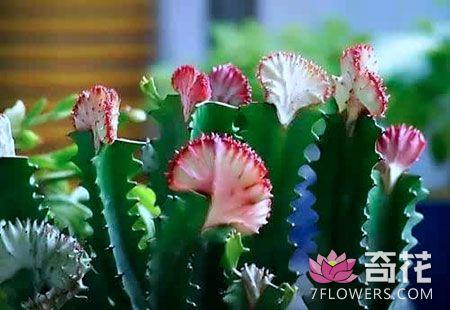
扦插龙骨基质需用蛭石、珍珠粉粒、纯河沙,不掺土。可单株扦插,也可多株集中扦插,插后浇水,只浇至插穗切口处,放阳光充足地方。生根期尽量少浇水,不干不浇,待30天至40天,即可生根。生根后进行移栽,盆土要求1/2河沙和1/2壤土混均后栽入,用2%高锰酸钾水浇入,既做了土壤消毒,又浇了水,植株高的可用支棍绑缚固定。培养时放阳光充足处,仍需控制水量,宁干勿湿为佳。

扦插龙骨基质需用蛭石、珍珠粉粒、纯河沙,不掺土。可单株扦插,也可多株集中扦插,插后浇水,只浇至插穗切口处,放阳光充足地方。生根期尽量少浇水,不干不浇,待30天至40天,即可生根。生根后进行移栽,盆土要求1/2河沙和1/2壤土混均后栽入,用2%高锰酸钾水浇入,既做了土壤消毒,又浇了水,植株高的可用支棍绑缚固定。培养时放阳光充足处,仍需控制水量,宁干勿湿为佳。
0
1
文章
权问薇
2017年07月28日

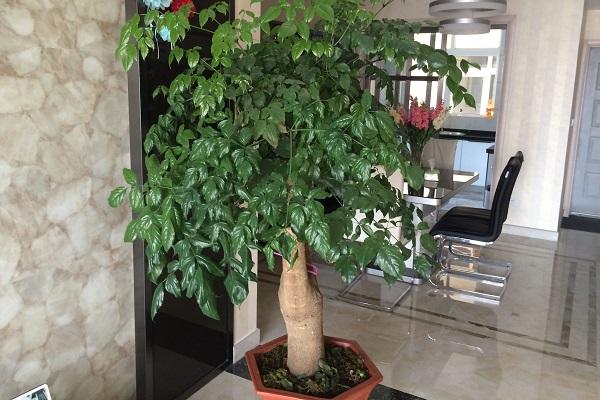
富贵树的养殖方法和注意事项
种植的时间
栽培最佳时间在10月下旬降霜后或是4月中上旬发芽前进行;移栽时间在春、夏、秋三季均可,移栽时若在生长期需要带土移栽。5月上旬以前或10月中旬以后是引种根最佳时间。
土壤
栽培宜用富含有机质、排水良好、疏松肥沃的壤土或沙质壤土。

浇水
生长时期盆土应保持潮湿,切忌土壤过于干燥,酷夏时期,要经常给叶子喷水,以防过于干燥,会使叶子干枯,但是冬季的盆土不要太过潮湿,同样要经常给叶子喷水,保持也自然湿润。
温度
可耐寒亦可耐热,零下33℃低温,可正常生存;耐热,生长更迅速。

光照
在春、秋两季要每天有3~4小时光照时间,这样可以保持叶子的油绿色泽。夏季和秋季的时候,养护过程中需要进行遮阳,并保证充足的空气湿度和土壤湿度,适时的进行叶面的清洗,会使得植株的生长更加旺盛。
注意事项
富贵树对肥料的要求不高,但每20~25天施肥一次,氮、磷、钾复合肥会使其生长的更加旺盛。富贵树要保持充足的水分,每两天必须浇灌一次,每次浇灌时最好把土全部浇湿润,水分的充裕,可以提高贵树的光合作用。
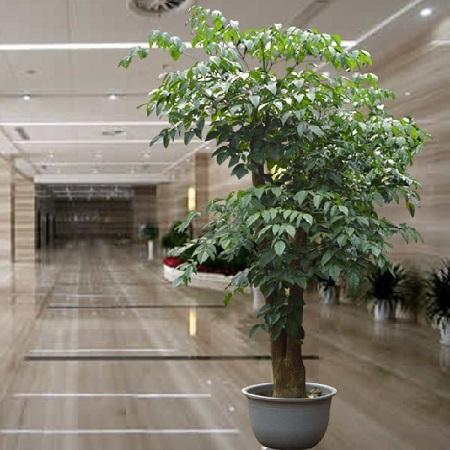
富贵树名字寓意很好,对净化空气起到很大作用,同时也很容易融合进家居摆设里,适合很多场合。快让富贵树成为你家中的一道迷人的风景线吧。
0
0
文章
Dummer. ゛☀
2017年07月28日

Family - Primulaceae
Stems - Scape to +30cm tall, glabrous, 3mm in diameter, from slightly thickened roots.

Leaves - Basal, spatulate, +10cm long, +2cm broad, entire, obtuse, glabrous.

Inflorescence - Umbellate cluster terminating scape, with +/-10 flowers. Pedicels glabrous, curving, to +4cm long, longer in fruit.
Flowers - Corolla tube 2-2.5mm long, 5-lobed. Lobes spreading at first and then sharply recurving, +/-2cm long, 7mm broad, glabrous, purple or white with yellow and maroon spotting at the base near the corolla tube throat. Stamens 5, borne at apex of corolla tube, opposite the corolla lobes, connate around the ovary, connivent around the style. Anthers long, +/-8mm, attenuate. Anther connective lilac to purple, yellow below, smooth. Ovary green, glabrous, cylindric, to 4mm long, 2mm in diameter, seeds (ovules) many. Placentation free-central. Calyx tube 3mm long, 3.5mm broad, glabrous. Calyx lobes 5, attenuate, 5mm long, alternating with the corolla lobes, spreading.

Flowering - April - June.
Habitat - Prairies, meadows, hillsides, open woods, rock outcrops.
Origin - Native to U.S.
Other info. - This is a very striking plant which is found throughout much of Missouri except the northwestern corner. The flowers can range from purplish to white but are most commonly purplish. This is an easy species to identify because of its big basal leaves and unmistakable flowers.
Stems - Scape to +30cm tall, glabrous, 3mm in diameter, from slightly thickened roots.

Leaves - Basal, spatulate, +10cm long, +2cm broad, entire, obtuse, glabrous.

Inflorescence - Umbellate cluster terminating scape, with +/-10 flowers. Pedicels glabrous, curving, to +4cm long, longer in fruit.
Flowers - Corolla tube 2-2.5mm long, 5-lobed. Lobes spreading at first and then sharply recurving, +/-2cm long, 7mm broad, glabrous, purple or white with yellow and maroon spotting at the base near the corolla tube throat. Stamens 5, borne at apex of corolla tube, opposite the corolla lobes, connate around the ovary, connivent around the style. Anthers long, +/-8mm, attenuate. Anther connective lilac to purple, yellow below, smooth. Ovary green, glabrous, cylindric, to 4mm long, 2mm in diameter, seeds (ovules) many. Placentation free-central. Calyx tube 3mm long, 3.5mm broad, glabrous. Calyx lobes 5, attenuate, 5mm long, alternating with the corolla lobes, spreading.

Flowering - April - June.
Habitat - Prairies, meadows, hillsides, open woods, rock outcrops.
Origin - Native to U.S.
Other info. - This is a very striking plant which is found throughout much of Missouri except the northwestern corner. The flowers can range from purplish to white but are most commonly purplish. This is an easy species to identify because of its big basal leaves and unmistakable flowers.
0
0
文章
Dummer. ゛☀
2017年07月28日

Family - Scrophulariaceae
Stems - Multiple from the base, prostrate to ascending, rooting at the nodes, branching, from fibrous roots, to +30cm long (10-15cm tall), antrorse puberulent, herbaceous.

Leaves - Opposite, very short-petiolate. Petioles to 1mm long, glabrous. Blades orbicular, entire to slightly crenate, green, +/-9mm long, +7mm broad, mostly glabrous or with a few antrorse hairs on margins near the base. Leaves reduced to bracts in inflorescence.

Inflorescence - Terminal bracteate racemes. Pedicels to 2mm long, antrorse puberulent, shorter than the subtending bract.
Flowers - Corolla zygomorphic, whitish-blue with purple stripes internally, glabrous externally, pubescent internally near the apex of the corolla tube, 4-lobed. Corolla tube to .8mm long. Lobes rounded, to 3mm long and broad, entire. Lower lobe reduced. Stamens 2, erect, exserted, alternate and adnate between lateral and central lobes. Filaments to 3mm long, clavate, white, glabrous. Anthers purple, .3mm long. Ovary superior, glandular pubescent, spherical, green, 1.2mm in diameter, 2 locular, many seeded. Placentation axile. Style 2mm long in flower, glabrous, translucent to purple near the apex. Stigma capitate. Sepals 4, green, unequal, persistent, mostly glabrous but with some antrorse cilia on margins, to -3mm long, 2mm broad in flower, sub-acute to rounded at apex. Fruit obcordate, to 5mm broad, 4mm long, with some glandular pubescence on margins, with a persistent long style.

Flowering - April - July, sometimes again in the fall.
Habitat - Low wet woods, spring branches, wet slopes, grassy places, waste ground.
Origin - Native to Europe.
Other info. - This little species can be found in the southeastern corner on Missouri. The plant forms mats when left undisturbed. This species is easy to ID because of its growing habit, rounded leaves, and whitish-blue flowers.
Stems - Multiple from the base, prostrate to ascending, rooting at the nodes, branching, from fibrous roots, to +30cm long (10-15cm tall), antrorse puberulent, herbaceous.

Leaves - Opposite, very short-petiolate. Petioles to 1mm long, glabrous. Blades orbicular, entire to slightly crenate, green, +/-9mm long, +7mm broad, mostly glabrous or with a few antrorse hairs on margins near the base. Leaves reduced to bracts in inflorescence.

Inflorescence - Terminal bracteate racemes. Pedicels to 2mm long, antrorse puberulent, shorter than the subtending bract.
Flowers - Corolla zygomorphic, whitish-blue with purple stripes internally, glabrous externally, pubescent internally near the apex of the corolla tube, 4-lobed. Corolla tube to .8mm long. Lobes rounded, to 3mm long and broad, entire. Lower lobe reduced. Stamens 2, erect, exserted, alternate and adnate between lateral and central lobes. Filaments to 3mm long, clavate, white, glabrous. Anthers purple, .3mm long. Ovary superior, glandular pubescent, spherical, green, 1.2mm in diameter, 2 locular, many seeded. Placentation axile. Style 2mm long in flower, glabrous, translucent to purple near the apex. Stigma capitate. Sepals 4, green, unequal, persistent, mostly glabrous but with some antrorse cilia on margins, to -3mm long, 2mm broad in flower, sub-acute to rounded at apex. Fruit obcordate, to 5mm broad, 4mm long, with some glandular pubescence on margins, with a persistent long style.

Flowering - April - July, sometimes again in the fall.
Habitat - Low wet woods, spring branches, wet slopes, grassy places, waste ground.
Origin - Native to Europe.
Other info. - This little species can be found in the southeastern corner on Missouri. The plant forms mats when left undisturbed. This species is easy to ID because of its growing habit, rounded leaves, and whitish-blue flowers.
0
0
文章
Colour_
2017年07月27日

多年生肉质草本植物,茎粗壮,灰白色,多分枝,叶对生,排列紧密。叶片倒卵形,长10~15厘米,宽5~7厘米,全缘,先端钝圆。叶色淡绿或黄绿,被有浓厚的白粉,因此,看上去呈灰绿色,秋末至初春的冷凉季节,在阳光充足的条件下,叶缘呈红色。小花筒形,黄色,长1.5厘米。原产南非开普省东部和德兰士瓦省。
形态特征
多年生肉质草本植物,茎粗壮,灰白色,多分枝,叶对生,排列紧密。叶片倒卵形,长10~1
5厘米,宽5~7厘米,全缘,先端钝圆。叶色淡绿或黄绿,被有浓厚的白粉,因此,看上去呈灰绿色,秋末至初春的冷凉季节,在阳光充足的条件下,叶缘呈红色。小花筒形,黄色,长1.5厘米。叶色淡绿,上披有一层厚厚的白粉,呈灰绿色,叶缘有一圈红色线条,在冷凉季节,于阳光充足的户外,叶缘会出现渐层的红色色斑。

唐印烂根的原因
唐印烂根,通常是浇水不当引起的。春秋冬夏的四季养护,对于水分的需求是不同的。春秋适宜保持盆土微潮,冬夏适宜保持盆土适当干燥,如果浇水过勤,非常容易烂根。
唐印烂根的后果
唐印烂根,会导致叶片干枯萎缩,皱皱巴巴的,不仅不通透红艳,还像个干瘦的老太太,一点没有唐美人的风采。
严重时,甚至会引起植株死亡。

唐印烂根的补救措施
勤观察,发现植株状态不好,要及时检查根部的情况。
烂根之后,要切掉腐烂的部分,晾晒一到两天,重新栽种。顺便剪除枯萎的叶片,让她在新的盆土里长出更好的叶片。
根部腐烂严重的,可以直接砍头重新扦插,长出一盆新的唐美人来!
形态特征
多年生肉质草本植物,茎粗壮,灰白色,多分枝,叶对生,排列紧密。叶片倒卵形,长10~1
5厘米,宽5~7厘米,全缘,先端钝圆。叶色淡绿或黄绿,被有浓厚的白粉,因此,看上去呈灰绿色,秋末至初春的冷凉季节,在阳光充足的条件下,叶缘呈红色。小花筒形,黄色,长1.5厘米。叶色淡绿,上披有一层厚厚的白粉,呈灰绿色,叶缘有一圈红色线条,在冷凉季节,于阳光充足的户外,叶缘会出现渐层的红色色斑。

唐印烂根的原因
唐印烂根,通常是浇水不当引起的。春秋冬夏的四季养护,对于水分的需求是不同的。春秋适宜保持盆土微潮,冬夏适宜保持盆土适当干燥,如果浇水过勤,非常容易烂根。
唐印烂根的后果
唐印烂根,会导致叶片干枯萎缩,皱皱巴巴的,不仅不通透红艳,还像个干瘦的老太太,一点没有唐美人的风采。
严重时,甚至会引起植株死亡。

唐印烂根的补救措施
勤观察,发现植株状态不好,要及时检查根部的情况。
烂根之后,要切掉腐烂的部分,晾晒一到两天,重新栽种。顺便剪除枯萎的叶片,让她在新的盆土里长出更好的叶片。
根部腐烂严重的,可以直接砍头重新扦插,长出一盆新的唐美人来!
0
0
文章
Colour_
2017年07月25日

变叶木灌木或小乔木。色彩鲜艳、光亮。常盆栽,原产马来西亚及太平洋地区。可高达6公尺(20尺)。叶片含花青素,单色或绿、黄、白、橙、红、粉红、大红及紫等,诸色相杂叶长10~15公分(4~6寸),形态因品种不同而异,呈细长线形、披针形、卵形或有深裂。变叶木以其叶片形色而得名,其叶形有披针形、卵形、椭圆形,还有波浪起伏状、扭曲状等等。其叶色有亮绿色、白色、灰色、红色、淡红色、深红色、紫色、黄色、黄红色等等。
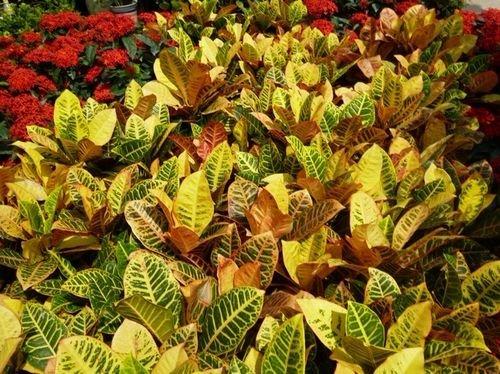
洒金榕掉叶子原因
1.温度不当
在养殖洒金榕的时候,需要给予它一个温暖的环境。洒金榕喜欢温暖并且不耐寒,它的生长的适宜温度是在20℃——30℃之间,在冬季的时候环境的温度最好也不要太低了。
在冬季的时候,如果短时间内,洒金榕的温度保持在10℃左右,就会使其出现叶子不鲜艳并且缺乏光泽的现象。如果养护的温度在4℃——5℃的时候,洒金榕就会出现冻害,叶子受冻。导致其大量的掉叶子,甚至是冻死。
所以在养殖洒金榕的时候,冬季一定要保持较高的温度,在进行养护的时候,温度不要低于13℃。
2.浇水不足
洒金榕是喜欢湿润的植物,在进行养殖的时候,一定要给予洒金榕充足的水分,并且需要经常向洒金榕的植株来喷水,提高空气湿度。不过在冬季的时候,因为温度比较低,所以需要保持干燥,此时植株已经进入了半休眠的状态,如果浇水太多的话,就会导致洒金榕掉叶子了。
在给洒金榕浇水的时候,一定要注意在冬季的时候,浇水不能太多了。
3.光照不足
洒金榕是喜欢光照的植物,在养殖洒金榕的时候一定要在其生长期间满足它对光照的需求,这样它才会生长良好。不过在室内养殖的时候,光照的条件可能不会很好,如果长时间光照不足的话,就会使洒金榕叶子颜色暗淡,缺少光泽,甚至会掉叶子。所以在养殖洒金榕的时候,光照一定要充足,在室内也要放在可以接触到阳光的地方进行养护。


洒金榕掉叶子原因
1.温度不当
在养殖洒金榕的时候,需要给予它一个温暖的环境。洒金榕喜欢温暖并且不耐寒,它的生长的适宜温度是在20℃——30℃之间,在冬季的时候环境的温度最好也不要太低了。
在冬季的时候,如果短时间内,洒金榕的温度保持在10℃左右,就会使其出现叶子不鲜艳并且缺乏光泽的现象。如果养护的温度在4℃——5℃的时候,洒金榕就会出现冻害,叶子受冻。导致其大量的掉叶子,甚至是冻死。
所以在养殖洒金榕的时候,冬季一定要保持较高的温度,在进行养护的时候,温度不要低于13℃。
2.浇水不足
洒金榕是喜欢湿润的植物,在进行养殖的时候,一定要给予洒金榕充足的水分,并且需要经常向洒金榕的植株来喷水,提高空气湿度。不过在冬季的时候,因为温度比较低,所以需要保持干燥,此时植株已经进入了半休眠的状态,如果浇水太多的话,就会导致洒金榕掉叶子了。
在给洒金榕浇水的时候,一定要注意在冬季的时候,浇水不能太多了。
3.光照不足
洒金榕是喜欢光照的植物,在养殖洒金榕的时候一定要在其生长期间满足它对光照的需求,这样它才会生长良好。不过在室内养殖的时候,光照的条件可能不会很好,如果长时间光照不足的话,就会使洒金榕叶子颜色暗淡,缺少光泽,甚至会掉叶子。所以在养殖洒金榕的时候,光照一定要充足,在室内也要放在可以接触到阳光的地方进行养护。

0
0
文章
Colour_
2017年07月25日

仙客来生长习性
喜凉爽、湿润及阳光 充足的环境。生长和花芽分化的适温为15—20℃,湿 度70%一75%;冬季花期 温度不得低于10℃,若温度过低,则花色暗淡,且易凋落;夏季温度若达到 28—30℃,则植株休眠,若达到35℃以上,则块茎易于腐烂。幼苗较老株耐热 性稍强。为中日照植物,生长季节的适宜光照强度为28000Lx,低于1500Lx或高 于45000LX,则光合强度明显下降。要求疏松、肥沃、富含腐殖质,排水良好的 微酸性沙壤土。花期10月至翌年4月。
仙客来叶子为什么会发黄

仙客来叶子卷曲发黄
叶子卷曲发黄是仙客来叶子发黄比较常见的一种情况,基本上发生这种现象,就是仙客来的植株缺乏营养了,要及时的补充养分。需要做的就是及时的进行施肥。可以去买一些专用的花肥,或者是自己在土壤里面加上一些熟黄豆、豆饼之类的,也能起到补充营养的作用。
仙客来花茎腐烂,花叶发黄
仙客来出现花茎腐烂并且花叶都发黄的现象,这可能就是浇水浇太多了,导致其出现烂根了。
所以,在养殖仙客来的时候,就要注意,浇水要适量。发现其出现这样的现象的时候,要停止浇水,等到其他人干透之后再浇水。
仙客来叶子发黄并且干枯
仙客来出现叶子发黄并且干枯的现象,这个多是因为在养殖仙客来的时候,盆土透气性太差了,或者是盆土过于干燥导致的。
可以给仙客来更换一些透气性比较好的土壤,并且注意从底部来浇水,浇水的水温要注意和室内的温度相接近。

仙客来叶面干枯发黄
仙客来有时候叶面也会出现干枯发黄的现象,因为仙客来的植株在浇水的时候,如果不小心浇在叶子上,很容易存水,时间一久就会产生水渍,导致叶面呼吸不畅,出现干枯发黄的现象,并且会影响观赏。
所以在给仙客来浇水的时候一定要注意,并且最好是及时的将水分用比较柔软的布擦干。
喜凉爽、湿润及阳光 充足的环境。生长和花芽分化的适温为15—20℃,湿 度70%一75%;冬季花期 温度不得低于10℃,若温度过低,则花色暗淡,且易凋落;夏季温度若达到 28—30℃,则植株休眠,若达到35℃以上,则块茎易于腐烂。幼苗较老株耐热 性稍强。为中日照植物,生长季节的适宜光照强度为28000Lx,低于1500Lx或高 于45000LX,则光合强度明显下降。要求疏松、肥沃、富含腐殖质,排水良好的 微酸性沙壤土。花期10月至翌年4月。
仙客来叶子为什么会发黄

仙客来叶子卷曲发黄
叶子卷曲发黄是仙客来叶子发黄比较常见的一种情况,基本上发生这种现象,就是仙客来的植株缺乏营养了,要及时的补充养分。需要做的就是及时的进行施肥。可以去买一些专用的花肥,或者是自己在土壤里面加上一些熟黄豆、豆饼之类的,也能起到补充营养的作用。
仙客来花茎腐烂,花叶发黄
仙客来出现花茎腐烂并且花叶都发黄的现象,这可能就是浇水浇太多了,导致其出现烂根了。
所以,在养殖仙客来的时候,就要注意,浇水要适量。发现其出现这样的现象的时候,要停止浇水,等到其他人干透之后再浇水。
仙客来叶子发黄并且干枯
仙客来出现叶子发黄并且干枯的现象,这个多是因为在养殖仙客来的时候,盆土透气性太差了,或者是盆土过于干燥导致的。
可以给仙客来更换一些透气性比较好的土壤,并且注意从底部来浇水,浇水的水温要注意和室内的温度相接近。

仙客来叶面干枯发黄
仙客来有时候叶面也会出现干枯发黄的现象,因为仙客来的植株在浇水的时候,如果不小心浇在叶子上,很容易存水,时间一久就会产生水渍,导致叶面呼吸不畅,出现干枯发黄的现象,并且会影响观赏。
所以在给仙客来浇水的时候一定要注意,并且最好是及时的将水分用比较柔软的布擦干。
0
0





